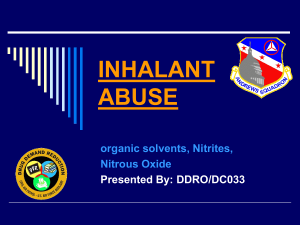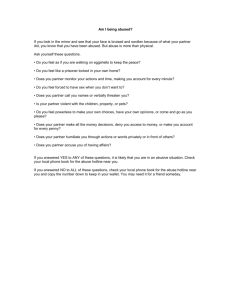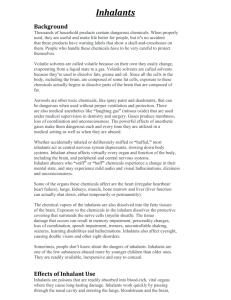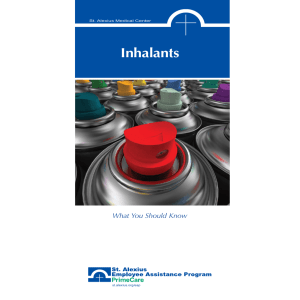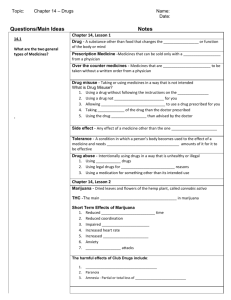INTERNATIONAL INHALANT ABUSE WORKING GROUP
advertisement
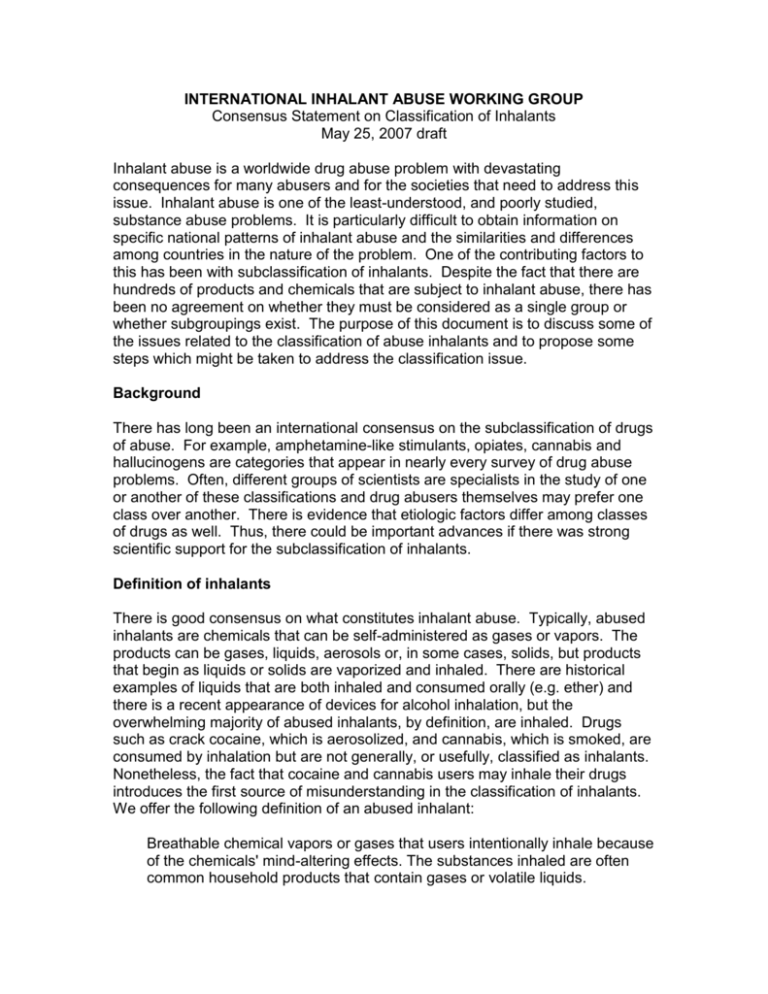
INTERNATIONAL INHALANT ABUSE WORKING GROUP Consensus Statement on Classification of Inhalants May 25, 2007 draft Inhalant abuse is a worldwide drug abuse problem with devastating consequences for many abusers and for the societies that need to address this issue. Inhalant abuse is one of the least-understood, and poorly studied, substance abuse problems. It is particularly difficult to obtain information on specific national patterns of inhalant abuse and the similarities and differences among countries in the nature of the problem. One of the contributing factors to this has been with subclassification of inhalants. Despite the fact that there are hundreds of products and chemicals that are subject to inhalant abuse, there has been no agreement on whether they must be considered as a single group or whether subgroupings exist. The purpose of this document is to discuss some of the issues related to the classification of abuse inhalants and to propose some steps which might be taken to address the classification issue. Background There has long been an international consensus on the subclassification of drugs of abuse. For example, amphetamine-like stimulants, opiates, cannabis and hallucinogens are categories that appear in nearly every survey of drug abuse problems. Often, different groups of scientists are specialists in the study of one or another of these classifications and drug abusers themselves may prefer one class over another. There is evidence that etiologic factors differ among classes of drugs as well. Thus, there could be important advances if there was strong scientific support for the subclassification of inhalants. Definition of inhalants There is good consensus on what constitutes inhalant abuse. Typically, abused inhalants are chemicals that can be self-administered as gases or vapors. The products can be gases, liquids, aerosols or, in some cases, solids, but products that begin as liquids or solids are vaporized and inhaled. There are historical examples of liquids that are both inhaled and consumed orally (e.g. ether) and there is a recent appearance of devices for alcohol inhalation, but the overwhelming majority of abused inhalants, by definition, are inhaled. Drugs such as crack cocaine, which is aerosolized, and cannabis, which is smoked, are consumed by inhalation but are not generally, or usefully, classified as inhalants. Nonetheless, the fact that cocaine and cannabis users may inhale their drugs introduces the first source of misunderstanding in the classification of inhalants. We offer the following definition of an abused inhalant: Breathable chemical vapors or gases that users intentionally inhale because of the chemicals' mind-altering effects. The substances inhaled are often common household products that contain gases or volatile liquids. Inhalant use research and policy study Although there is general consensus on what types of products are subject to inhalant abuse and there is a wide belief that the problem exists throughout the world, this problem has often been ignored in drug abuse survey research and in setting national an international drug control policy. Inhalant abuse is also frequently ignored in drug abuse prevention efforts. We recommend that all countries of the world and substance abuse experts in these countries include inhalant abuse among their general work in the substance abuse field. Specific abused inhalants The number of different specific chemicals and products which can be subject to inhalant abuse is very large. In the United States alone, some recent surveys attempting to obtain information on specific types of abused inhalants have used lists of over 60 different products or product types. If one adds all of the many different brands of the same chemical products, the number becomes much larger. If we add to this the even wider variety of abusable products throughout the world, it becomes obvious that the diversity of abused inhalants is far greater than is true for any other form of substance abuse. We believe that one of the places where we can improve our understanding of inhalant abuse is to obtain more detailed information on individual products, their patterns of use and the geographical distribution of their use. Classification systems for inhalants There are several bases on which abused inhalants might be classified. To simplify, these can be stated as follows: Chemically, based on structure Form, such as gas, vapor or aerosol Product type or intended use, such as fuels, anesthetics, cleaners, etc. Epidemiological patterns of abuse Pharmacological properties There are strengths and weaknesses to each of these classification schemes. Some of these will be discussed later. Ideally, several of these classifications schemes could be merged to identify, for example, chemical groups that share pharmacological properties and have distinctive patterns of use. We are not there yet, as there is not a sufficient database on unique chemicals, their pharmacological properties and their patterns of abuse to arrive at such a scheme. With this in mind, we recommend caution in developing subclassifications of inhalants that are not built upon strong scientific evidence. This is particularly true for classifications that might have a tendency to create enduring groupings that are subsequently shown to be premature or that only may apply to one country or cultural group (e.g. a diagnostic subclassification of inhalants). Chemical classification. So far, there has been little evidence that, with a few exceptions, chemical structure alone can confer differences in the abuse-related effects of inhalants. The clear exception to this are the volatile nitrites, which differ both chemically and pharmacologically from other inhalants. Historically, different types of users preferred nitrites than preferred solvents and other volatiles; however, this demographic difference may be eroding with time and may not apply throughout the world. Nonetheless, many studies if inhalants have considered volatile nitrites as a separate subclassification and there is reasonable scientific support for this. Form. A classification based on the form in which the product is obtained is common in the inhalant abuse field. It may be most useful for inhalant abuse prevention where parents and children are told what types of products to attend to. On the other hand, classifications based on form would be uncommon in the substance abuse field, and when it has been done, can often create many problems. The best example is with cocaine, where the salt can be abused orally or by injection and the base is usually used by inhaling the volatilized chemical. Heroin is abused in many forms, as are many other drugs of abuse. As with these other drugs of abuse, the same inhalant can be found in many different products in different forms. Toluene, for example, is found in both liquid forms and in aerosols. Indeed, aerosols are small droplets of chemicals that typically vaporize as they pass into the air, so abusers of aerosols obtain both the vapor and some of the small droplets. Thus, the distinction between aerosols and vapors is artificial. Product type. Many of the same problems with classification by form also apply to classification by product type or intended use. The same chemical many be in many types of products with many intended uses. Also, there many be too many product types for useful classification. On the other hand, inhalant users and consumers are most likely to know these products by their type and intended use, so questionnaires attempting to obtain detailed information about individual products will necessarily need to include lists of product types. Epidemiological pattern of use. There has been very little research so far using epidemiological methods to determine of classes of inhalants can be found based on patterns or consequences of use. As mentioned above, there is some evidence that nitrites might be preferred by special groups of users. Nitrous oxide is also well known to be widely abused among health professionals, and also may have a unique demography of use. We recommend that more research be conducted on the epidemiology of specific inhalant products in a wide variety of cultures to help inform the classification of inhalant based on demographics of use. Pharmacological properties. Most other classes of drugs of abuse are based on grouping together those chemicals that share pharmacological effects that are related to their abuse. Thus, the ability to produce a similar intoxication, to produce cross-tolerance and cross-dependence and to produce distinctive patters of abstinence symptoms serves as the primary basis for classification of drugs of abuse. It is also well established that such a pharmacological classification predicts epidemiologic patters of abuse. Unfortunately, there has not been sufficient research to clearly identify pharmacological groupings of inhalants, with the major exception of nitrites. Generally, many inhalants produce pharmacological effects similar to those of alcohol and central nervous system depressant drugs. Volatile general anesthetics also produce effects similar to many abused inhalants and to depressant drugs, and these chemicals too have been subject to abuse. More research is needed in this area as well if progress is to be made on inhalant classification based on pharmacology and shared effects.
